Essay on Business Decision Making
VerifiedAdded on 2023/01/11
|7
|1267
|33
AI Summary
This essay discusses the process of business decision making, including the calculation of payback period and net present value (NPV). It also explores the advantages and disadvantages of these methods and the factors to consider in decision making.
Contribute Materials
Your contribution can guide someone’s learning journey. Share your
documents today.

Essay on Business Decision Making
Secure Best Marks with AI Grader
Need help grading? Try our AI Grader for instant feedback on your assignments.
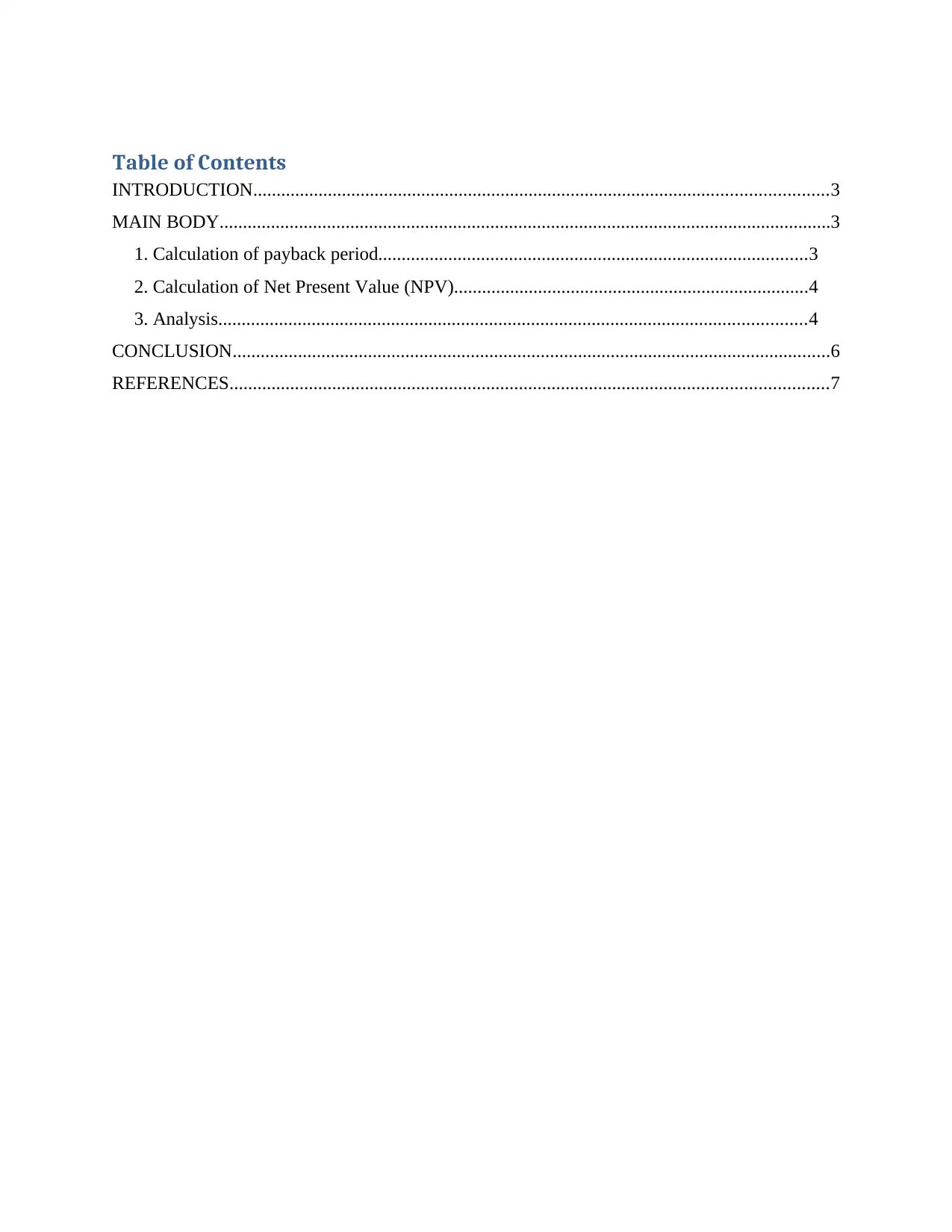
Table of Contents
INTRODUCTION...........................................................................................................................3
MAIN BODY...................................................................................................................................3
1. Calculation of payback period............................................................................................3
2. Calculation of Net Present Value (NPV)............................................................................4
3. Analysis..............................................................................................................................4
CONCLUSION................................................................................................................................6
REFERENCES................................................................................................................................7
INTRODUCTION...........................................................................................................................3
MAIN BODY...................................................................................................................................3
1. Calculation of payback period............................................................................................3
2. Calculation of Net Present Value (NPV)............................................................................4
3. Analysis..............................................................................................................................4
CONCLUSION................................................................................................................................6
REFERENCES................................................................................................................................7
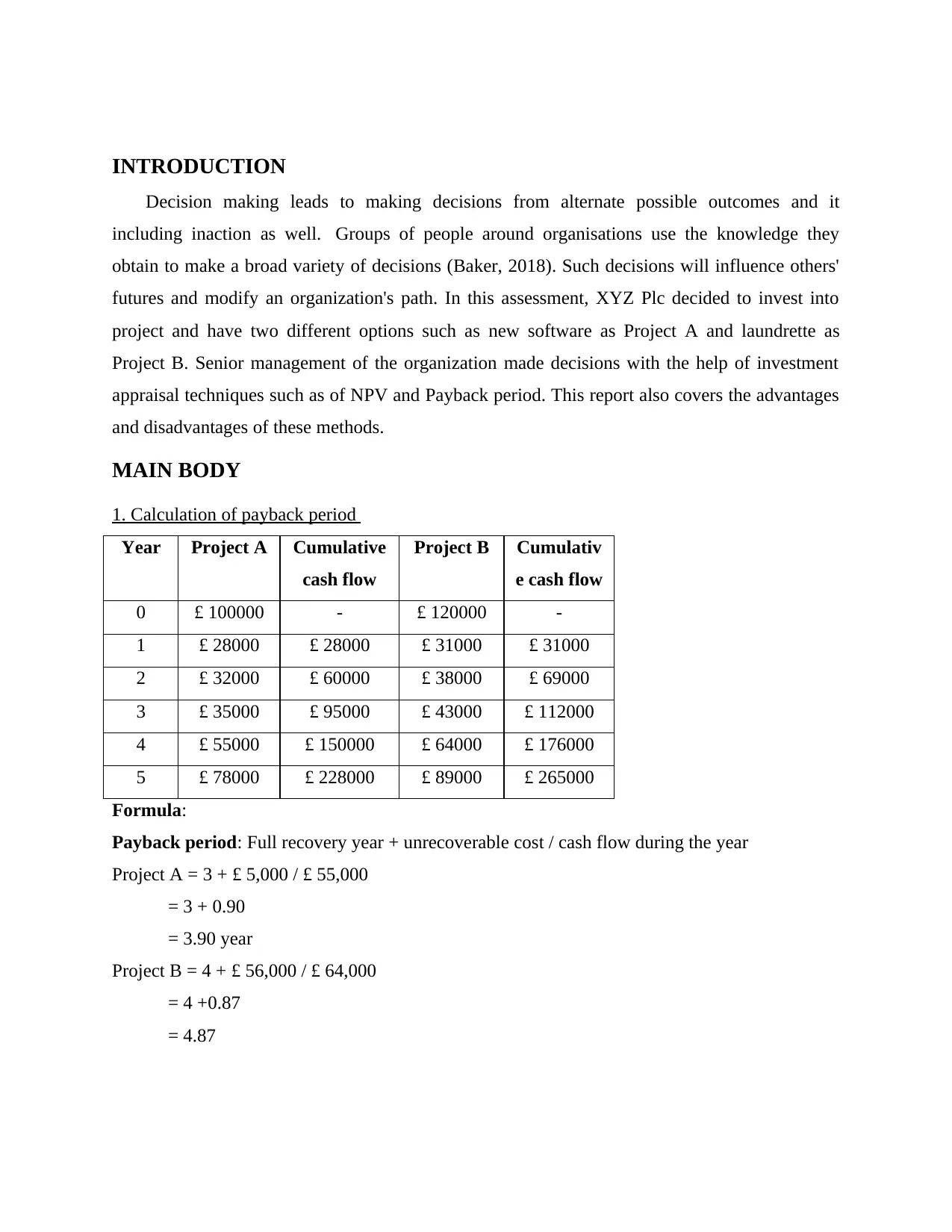
INTRODUCTION
Decision making leads to making decisions from alternate possible outcomes and it
including inaction as well. Groups of people around organisations use the knowledge they
obtain to make a broad variety of decisions (Baker, 2018). Such decisions will influence others'
futures and modify an organization's path. In this assessment, XYZ Plc decided to invest into
project and have two different options such as new software as Project A and laundrette as
Project B. Senior management of the organization made decisions with the help of investment
appraisal techniques such as of NPV and Payback period. This report also covers the advantages
and disadvantages of these methods.
MAIN BODY
1. Calculation of payback period
Year Project A Cumulative
cash flow
Project B Cumulativ
e cash flow
0 £ 100000 - £ 120000 -
1 £ 28000 £ 28000 £ 31000 £ 31000
2 £ 32000 £ 60000 £ 38000 £ 69000
3 £ 35000 £ 95000 £ 43000 £ 112000
4 £ 55000 £ 150000 £ 64000 £ 176000
5 £ 78000 £ 228000 £ 89000 £ 265000
Formula:
Payback period: Full recovery year + unrecoverable cost / cash flow during the year
Project A = 3 + £ 5,000 / £ 55,000
= 3 + 0.90
= 3.90 year
Project B = 4 + £ 56,000 / £ 64,000
= 4 +0.87
= 4.87
Decision making leads to making decisions from alternate possible outcomes and it
including inaction as well. Groups of people around organisations use the knowledge they
obtain to make a broad variety of decisions (Baker, 2018). Such decisions will influence others'
futures and modify an organization's path. In this assessment, XYZ Plc decided to invest into
project and have two different options such as new software as Project A and laundrette as
Project B. Senior management of the organization made decisions with the help of investment
appraisal techniques such as of NPV and Payback period. This report also covers the advantages
and disadvantages of these methods.
MAIN BODY
1. Calculation of payback period
Year Project A Cumulative
cash flow
Project B Cumulativ
e cash flow
0 £ 100000 - £ 120000 -
1 £ 28000 £ 28000 £ 31000 £ 31000
2 £ 32000 £ 60000 £ 38000 £ 69000
3 £ 35000 £ 95000 £ 43000 £ 112000
4 £ 55000 £ 150000 £ 64000 £ 176000
5 £ 78000 £ 228000 £ 89000 £ 265000
Formula:
Payback period: Full recovery year + unrecoverable cost / cash flow during the year
Project A = 3 + £ 5,000 / £ 55,000
= 3 + 0.90
= 3.90 year
Project B = 4 + £ 56,000 / £ 64,000
= 4 +0.87
= 4.87
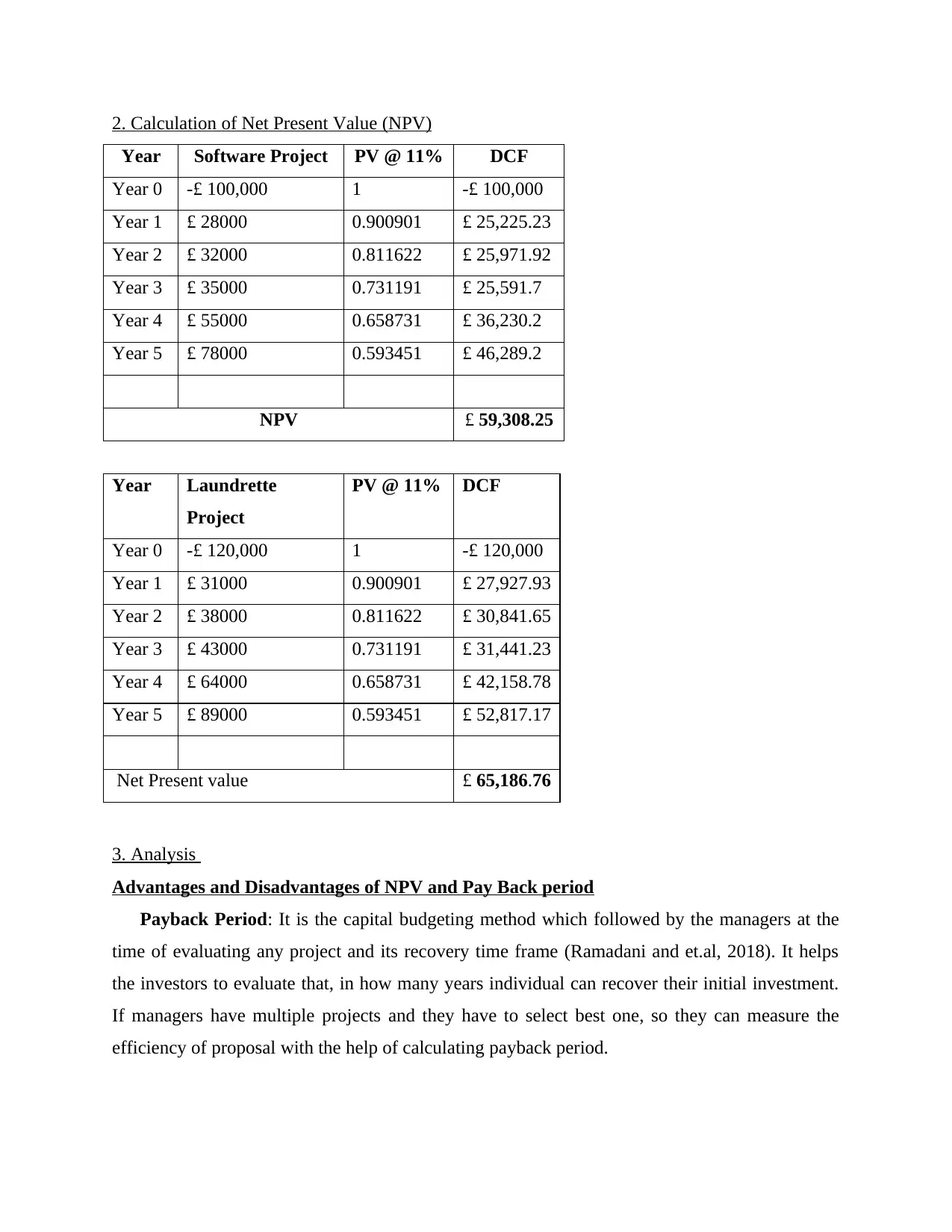
2. Calculation of Net Present Value (NPV)
Year Software Project PV @ 11% DCF
Year 0 -£ 100,000 1 -£ 100,000
Year 1 £ 28000 0.900901 £ 25,225.23
Year 2 £ 32000 0.811622 £ 25,971.92
Year 3 £ 35000 0.731191 £ 25,591.7
Year 4 £ 55000 0.658731 £ 36,230.2
Year 5 £ 78000 0.593451 £ 46,289.2
NPV £ 59,308.25
Year Laundrette
Project
PV @ 11% DCF
Year 0 -£ 120,000 1 -£ 120,000
Year 1 £ 31000 0.900901 £ 27,927.93
Year 2 £ 38000 0.811622 £ 30,841.65
Year 3 £ 43000 0.731191 £ 31,441.23
Year 4 £ 64000 0.658731 £ 42,158.78
Year 5 £ 89000 0.593451 £ 52,817.17
Net Present value £ 65,186.76
3. Analysis
Advantages and Disadvantages of NPV and Pay Back period
Payback Period: It is the capital budgeting method which followed by the managers at the
time of evaluating any project and its recovery time frame (Ramadani and et.al, 2018). It helps
the investors to evaluate that, in how many years individual can recover their initial investment.
If managers have multiple projects and they have to select best one, so they can measure the
efficiency of proposal with the help of calculating payback period.
Year Software Project PV @ 11% DCF
Year 0 -£ 100,000 1 -£ 100,000
Year 1 £ 28000 0.900901 £ 25,225.23
Year 2 £ 32000 0.811622 £ 25,971.92
Year 3 £ 35000 0.731191 £ 25,591.7
Year 4 £ 55000 0.658731 £ 36,230.2
Year 5 £ 78000 0.593451 £ 46,289.2
NPV £ 59,308.25
Year Laundrette
Project
PV @ 11% DCF
Year 0 -£ 120,000 1 -£ 120,000
Year 1 £ 31000 0.900901 £ 27,927.93
Year 2 £ 38000 0.811622 £ 30,841.65
Year 3 £ 43000 0.731191 £ 31,441.23
Year 4 £ 64000 0.658731 £ 42,158.78
Year 5 £ 89000 0.593451 £ 52,817.17
Net Present value £ 65,186.76
3. Analysis
Advantages and Disadvantages of NPV and Pay Back period
Payback Period: It is the capital budgeting method which followed by the managers at the
time of evaluating any project and its recovery time frame (Ramadani and et.al, 2018). It helps
the investors to evaluate that, in how many years individual can recover their initial investment.
If managers have multiple projects and they have to select best one, so they can measure the
efficiency of proposal with the help of calculating payback period.
Secure Best Marks with AI Grader
Need help grading? Try our AI Grader for instant feedback on your assignments.
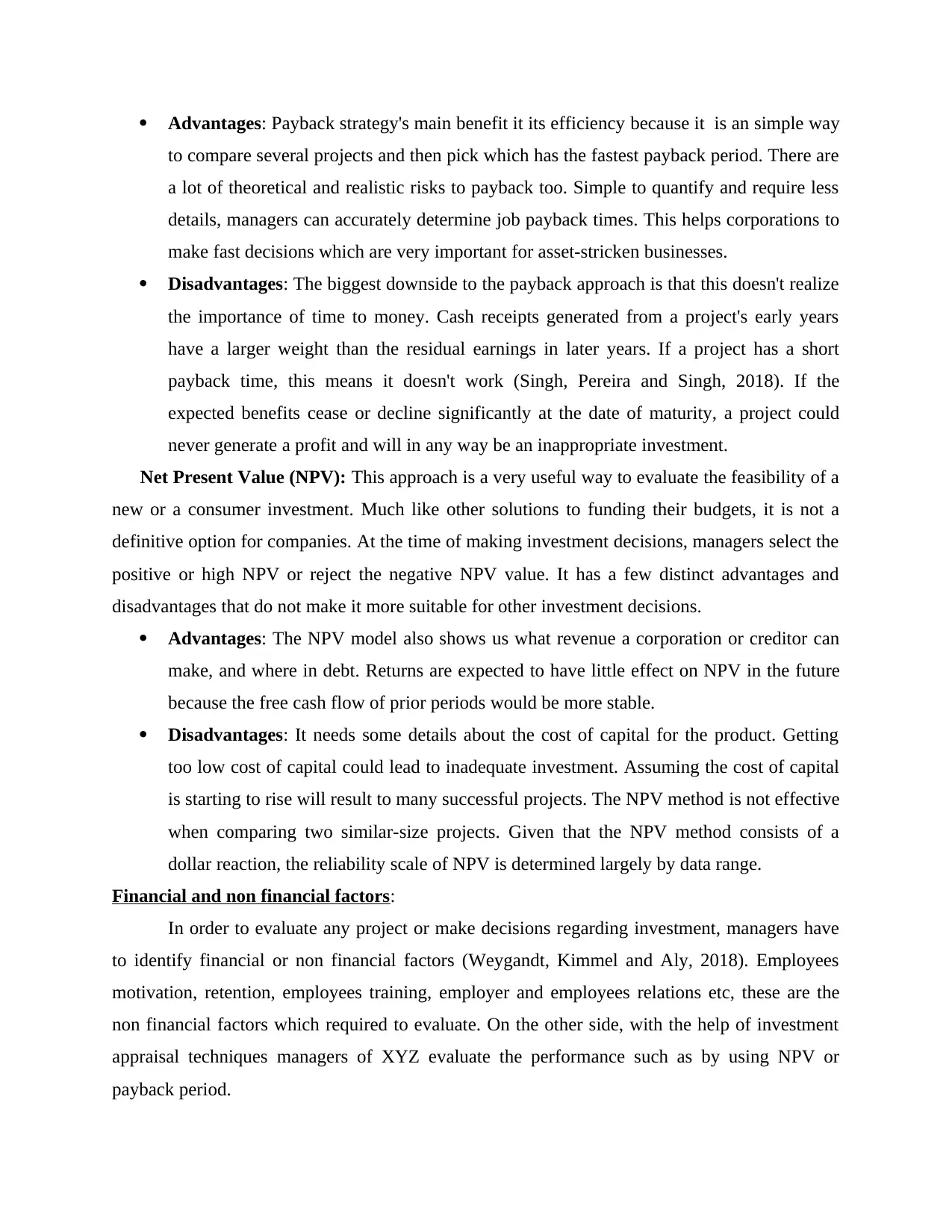
Advantages: Payback strategy's main benefit it its efficiency because it is an simple way
to compare several projects and then pick which has the fastest payback period. There are
a lot of theoretical and realistic risks to payback too. Simple to quantify and require less
details, managers can accurately determine job payback times. This helps corporations to
make fast decisions which are very important for asset-stricken businesses.
Disadvantages: The biggest downside to the payback approach is that this doesn't realize
the importance of time to money. Cash receipts generated from a project's early years
have a larger weight than the residual earnings in later years. If a project has a short
payback time, this means it doesn't work (Singh, Pereira and Singh, 2018). If the
expected benefits cease or decline significantly at the date of maturity, a project could
never generate a profit and will in any way be an inappropriate investment.
Net Present Value (NPV): This approach is a very useful way to evaluate the feasibility of a
new or a consumer investment. Much like other solutions to funding their budgets, it is not a
definitive option for companies. At the time of making investment decisions, managers select the
positive or high NPV or reject the negative NPV value. It has a few distinct advantages and
disadvantages that do not make it more suitable for other investment decisions.
Advantages: The NPV model also shows us what revenue a corporation or creditor can
make, and where in debt. Returns are expected to have little effect on NPV in the future
because the free cash flow of prior periods would be more stable.
Disadvantages: It needs some details about the cost of capital for the product. Getting
too low cost of capital could lead to inadequate investment. Assuming the cost of capital
is starting to rise will result to many successful projects. The NPV method is not effective
when comparing two similar-size projects. Given that the NPV method consists of a
dollar reaction, the reliability scale of NPV is determined largely by data range.
Financial and non financial factors:
In order to evaluate any project or make decisions regarding investment, managers have
to identify financial or non financial factors (Weygandt, Kimmel and Aly, 2018). Employees
motivation, retention, employees training, employer and employees relations etc, these are the
non financial factors which required to evaluate. On the other side, with the help of investment
appraisal techniques managers of XYZ evaluate the performance such as by using NPV or
payback period.
to compare several projects and then pick which has the fastest payback period. There are
a lot of theoretical and realistic risks to payback too. Simple to quantify and require less
details, managers can accurately determine job payback times. This helps corporations to
make fast decisions which are very important for asset-stricken businesses.
Disadvantages: The biggest downside to the payback approach is that this doesn't realize
the importance of time to money. Cash receipts generated from a project's early years
have a larger weight than the residual earnings in later years. If a project has a short
payback time, this means it doesn't work (Singh, Pereira and Singh, 2018). If the
expected benefits cease or decline significantly at the date of maturity, a project could
never generate a profit and will in any way be an inappropriate investment.
Net Present Value (NPV): This approach is a very useful way to evaluate the feasibility of a
new or a consumer investment. Much like other solutions to funding their budgets, it is not a
definitive option for companies. At the time of making investment decisions, managers select the
positive or high NPV or reject the negative NPV value. It has a few distinct advantages and
disadvantages that do not make it more suitable for other investment decisions.
Advantages: The NPV model also shows us what revenue a corporation or creditor can
make, and where in debt. Returns are expected to have little effect on NPV in the future
because the free cash flow of prior periods would be more stable.
Disadvantages: It needs some details about the cost of capital for the product. Getting
too low cost of capital could lead to inadequate investment. Assuming the cost of capital
is starting to rise will result to many successful projects. The NPV method is not effective
when comparing two similar-size projects. Given that the NPV method consists of a
dollar reaction, the reliability scale of NPV is determined largely by data range.
Financial and non financial factors:
In order to evaluate any project or make decisions regarding investment, managers have
to identify financial or non financial factors (Weygandt, Kimmel and Aly, 2018). Employees
motivation, retention, employees training, employer and employees relations etc, these are the
non financial factors which required to evaluate. On the other side, with the help of investment
appraisal techniques managers of XYZ evaluate the performance such as by using NPV or
payback period.
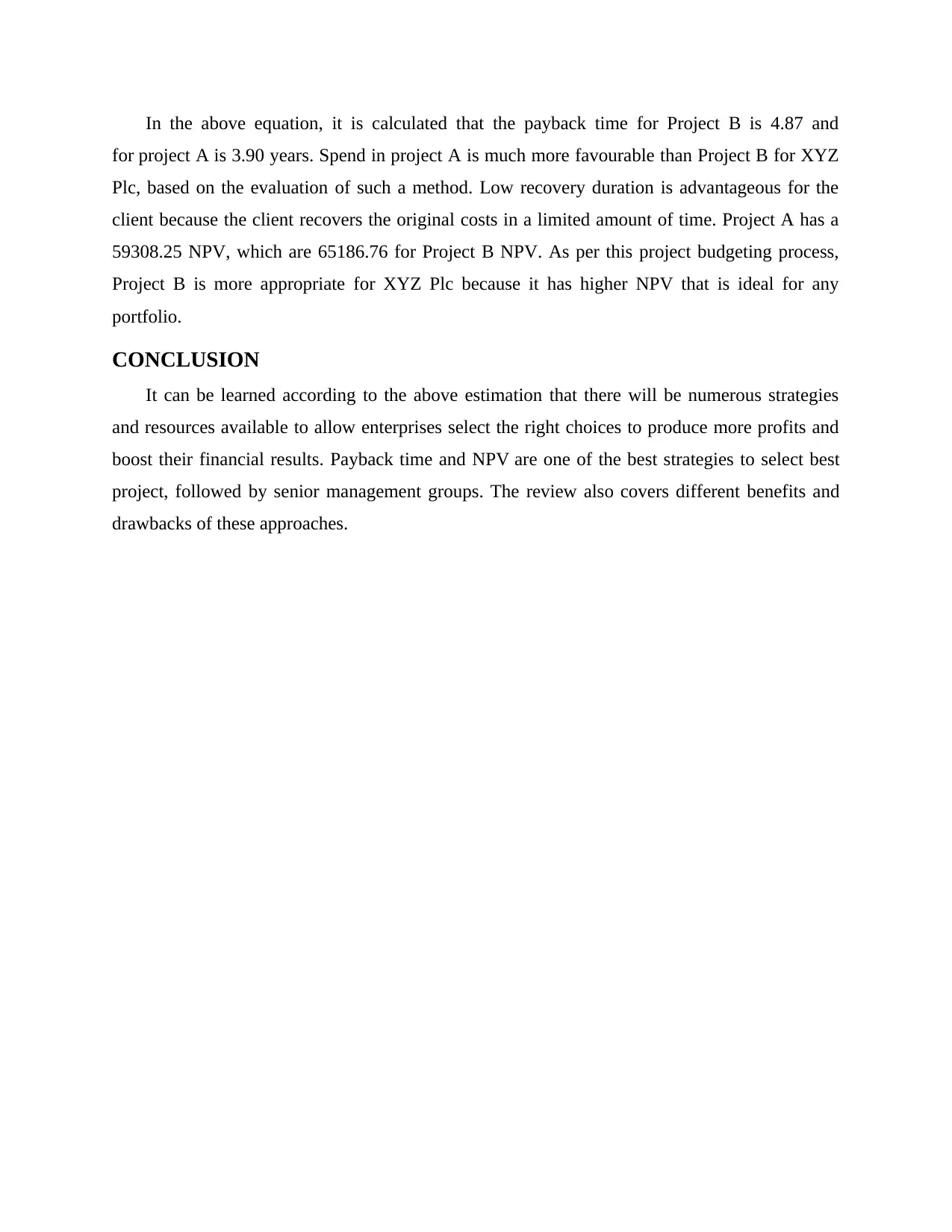
In the above equation, it is calculated that the payback time for Project B is 4.87 and
for project A is 3.90 years. Spend in project A is much more favourable than Project B for XYZ
Plc, based on the evaluation of such a method. Low recovery duration is advantageous for the
client because the client recovers the original costs in a limited amount of time. Project A has a
59308.25 NPV, which are 65186.76 for Project B NPV. As per this project budgeting process,
Project B is more appropriate for XYZ Plc because it has higher NPV that is ideal for any
portfolio.
CONCLUSION
It can be learned according to the above estimation that there will be numerous strategies
and resources available to allow enterprises select the right choices to produce more profits and
boost their financial results. Payback time and NPV are one of the best strategies to select best
project, followed by senior management groups. The review also covers different benefits and
drawbacks of these approaches.
for project A is 3.90 years. Spend in project A is much more favourable than Project B for XYZ
Plc, based on the evaluation of such a method. Low recovery duration is advantageous for the
client because the client recovers the original costs in a limited amount of time. Project A has a
59308.25 NPV, which are 65186.76 for Project B NPV. As per this project budgeting process,
Project B is more appropriate for XYZ Plc because it has higher NPV that is ideal for any
portfolio.
CONCLUSION
It can be learned according to the above estimation that there will be numerous strategies
and resources available to allow enterprises select the right choices to produce more profits and
boost their financial results. Payback time and NPV are one of the best strategies to select best
project, followed by senior management groups. The review also covers different benefits and
drawbacks of these approaches.
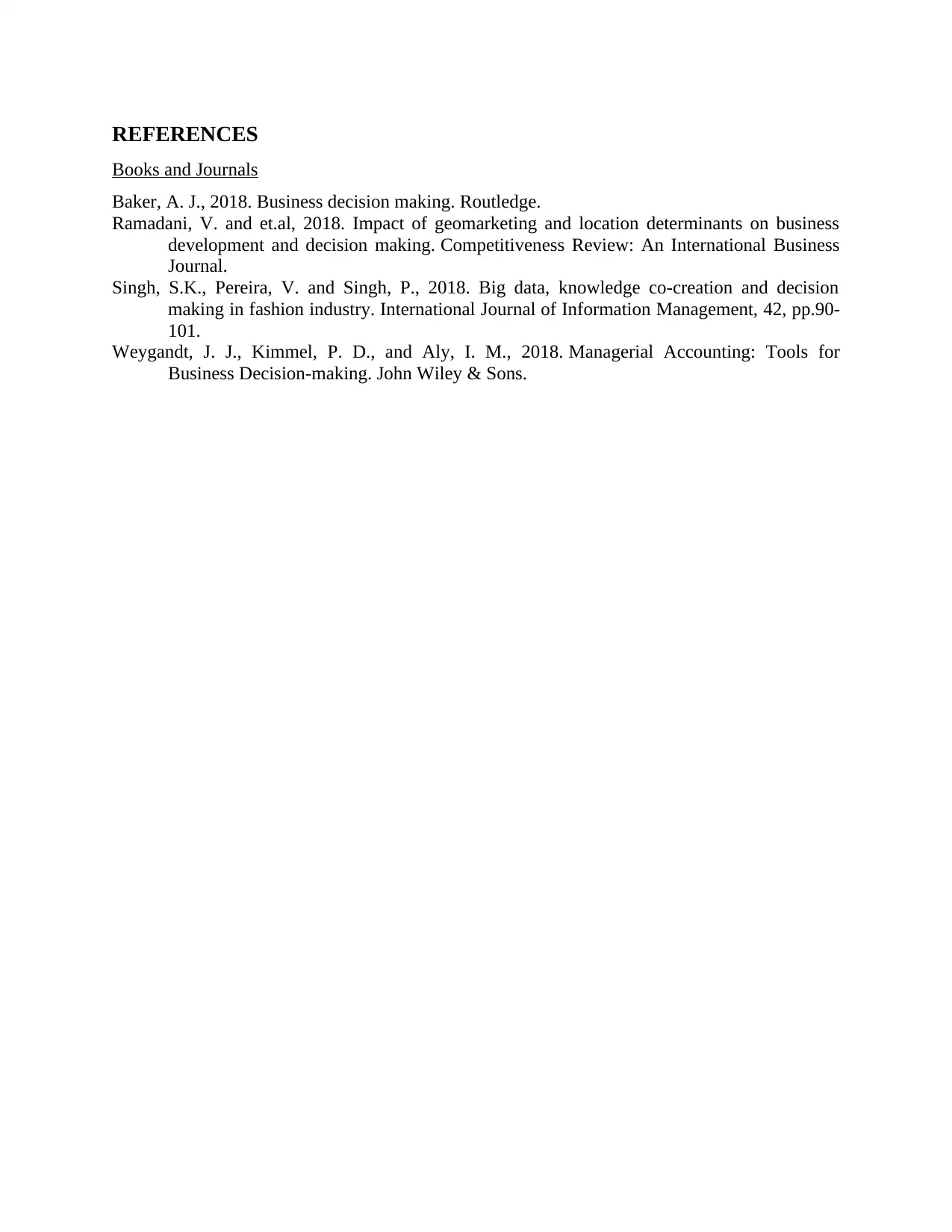
REFERENCES
Books and Journals
Baker, A. J., 2018. Business decision making. Routledge.
Ramadani, V. and et.al, 2018. Impact of geomarketing and location determinants on business
development and decision making. Competitiveness Review: An International Business
Journal.
Singh, S.K., Pereira, V. and Singh, P., 2018. Big data, knowledge co-creation and decision
making in fashion industry. International Journal of Information Management, 42, pp.90-
101.
Weygandt, J. J., Kimmel, P. D., and Aly, I. M., 2018. Managerial Accounting: Tools for
Business Decision-making. John Wiley & Sons.
Books and Journals
Baker, A. J., 2018. Business decision making. Routledge.
Ramadani, V. and et.al, 2018. Impact of geomarketing and location determinants on business
development and decision making. Competitiveness Review: An International Business
Journal.
Singh, S.K., Pereira, V. and Singh, P., 2018. Big data, knowledge co-creation and decision
making in fashion industry. International Journal of Information Management, 42, pp.90-
101.
Weygandt, J. J., Kimmel, P. D., and Aly, I. M., 2018. Managerial Accounting: Tools for
Business Decision-making. John Wiley & Sons.
1 out of 7
Related Documents
Your All-in-One AI-Powered Toolkit for Academic Success.
+13062052269
info@desklib.com
Available 24*7 on WhatsApp / Email
![[object Object]](/_next/static/media/star-bottom.7253800d.svg)
Unlock your academic potential
© 2024 | Zucol Services PVT LTD | All rights reserved.





